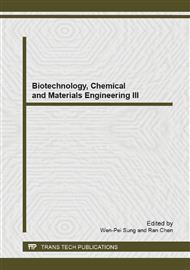[1]
KO, T., J., PARK, S., H. Experimental verification of the mist generation mechanism in turning. In: International Journal of Machine Tools & Manufacture. 2003. No. 43, p.115–120.
DOI: 10.1016/s0890-6955(02)00188-8
Google Scholar
[2]
GUNTER, K., L., SUTHERLAND, J., W. An experimental investigation into the effect of process conditions on the mass concentration of cutting fluid mist in turning. In: Journal of Cleaner Production. 1999. No. 7, p.341–350.
DOI: 10.1016/s0959-6526(99)00150-x
Google Scholar
[3]
SOKOVIC, M., MIJANOVIC, K. Ecological aspects of the cutting fluids and its influence on quantifiable parameters of the cutting processes. In: Journal of Materials Processing Technology. 2001. No. 109, pp.181-189.
DOI: 10.1016/s0924-0136(00)00794-9
Google Scholar
[4]
WICHMANN, H., STACHE, H., SCHMIDT, CH., et al. Ecological and economic evaluation of a novel glycerol based biocide-free metalworking fluid. In: Journal of Cleaner Production. 2013. pp.12-19.
DOI: 10.1016/j.jclepro.2012.12.042
Google Scholar
[5]
WINTER, M., BOCKA, R., HERRMA, CH. Investigation of a new ecologically benign metalworking fluid in abrasive machining processes to substitute mineral oil based fluids, 5th CIRP Conference on High Performance Cutting 2012, Procedia CIRP 1, 2012, p.393.
DOI: 10.1016/j.procir.2012.04.070
Google Scholar
[6]
Emission Scenario Document on Lubricants and Lubricant Additives. OECD Environmental Health And Safety Publications, Series On Emission Scenario Documents No. 10, December (2004).
DOI: 10.1787/9789264221154-en
Google Scholar
[7]
BATALLER, H., LAMAALLAM, S., LACHAISE, J., GRACIAA, A., DICHARRY, C. Cutting fluid emulsions produced by dilution of a cutting fluid concentrate containing a cationic/nonionic surfactant mixture. In: Journal of Materials Processing Technology. 2004. No. 152, p.215.
DOI: 10.1016/j.jmatprotec.2004.03.027
Google Scholar
[8]
JAIN, V., K., SHUKLA, D., S. The role of fatty materials and water soluble inorganic solids in synthetic metal working fluid. In: Wear, No. 208, 1997, pp.11-16.
DOI: 10.1016/s0043-1648(96)07402-9
Google Scholar
[9]
KELLY, J., F., COTTERELL, M., G. Minimal lubrication machining of aluminium alloys. In: Journal of Materials Processing Technology, No. 120, 2002, p.327–334.
DOI: 10.1016/s0924-0136(01)01126-8
Google Scholar
[10]
Emission scenario document on the use of metalworking fluids. OECD Environment, Health and Safety Publications Series on Emission Scenario Documents, No. 28, JT03304938, ENV/JM/MONO (2011).
DOI: 10.1787/9789264220980-en
Google Scholar
[11]
Optimising the use of metalworking fluids gg: 199 guide. Environmental Technology Best Practice Programme, Pera Technology.
Google Scholar
[12]
BROWN, W., L., BUTLER, R., G. Metalworking Fluids. Part of the book: Synthetics, Mineral Oils, and Bio-Based Lubricants, Chemistry and Technology. Edited by LESLIE R . RUDNICK. CRC Press 2005 Print, ISBN: 978-1-57444-723-1, eBook ISBN: 978-1-4200-2718-1, DOI: 10. 1201/9781420027181. ch36.
DOI: 10.1201/9781420027181.ch36
Google Scholar
[13]
Engineering and Design: Lubricants and Hydraulic Fluids. Department of the army, U.S. Army Corps of Engineers, Washington, DC 20314-1000, 31 July 2006, Manual No. 1110-2-1424.
Google Scholar
[14]
BAKALOVA, S., MINCHEVA, V., DOYCHEVA, A., et al., Microbial toxicity of ethanolamines. In: Biotechnology& Biotechnological Equipments, 2008, No. 2, Vol. 22, pp.716-720.
DOI: 10.1080/13102818.2008.10817540
Google Scholar
[15]
BAKALOVA, S., et al. Bacterial microflora of contaminated metalworking fluids, In: Biotechnology& Biotechnological Equipments, 2007, Vol. 21, No. 4, pp.437-441.
DOI: 10.1080/13102818.2007.10817490
Google Scholar
[16]
Metal Working Fluids - Recommendation for Chronic Inhalation Studies. National Institute for Occupational Safety and Health, Cincinnati OH USA 45226, April (2005).
Google Scholar
[17]
EKENGREN, Ö., NIEMINEN, I., BERGSTRÖM, R.: Environmentally acceptable metalworking processes, Ivl Swedish Environmental Vtt Research Institute, 2002-01-18, A96291.
Google Scholar
[18]
RYCROFT, R., J., G.,: Metalworking Industry - Occupational Dermatitis-What's New? In: Clinics in Dermatology, No. 15, 1997, pp.565-566.
DOI: 10.1016/s0738-081x(97)84091-6
Google Scholar
[19]
LEWIS, D., M., JANOTKA, E. Detection of microbial antigens in metal working fluids. In: International Biodeterioration & Biodegradation. 2001. No. 47, p.89–94.
DOI: 10.1016/s0964-8305(00)00114-1
Google Scholar
[20]
GAST, C., J., KNOWLES, C., J., WRIGHT, M., A.: Identiffication and characterisation of bacterial populations of an in-use metal-working fluid by phenotypic and genotypic methodology, In: International Biodeterioration & Biodegradation. 2001. No. 47, pp.113-123.
DOI: 10.1016/s0964-8305(01)00036-1
Google Scholar
[21]
Pollution Prevention Guide to Using Metal Removal Fluids in machining Operation. Institute of Advanced Manufacturing Sciences, Incorporated Machining Xcellence Division, Cincinnati, Ohio 45216.
Google Scholar
[22]
Metal Working Fluids - Recommendation for Chronic Inhalation Studies. National Institute for Occupational Safety and Health, Cincinnati OH USA 45226, April, (2005).
Google Scholar
[23]
SULIMAN, S., M., A., ABUBAKR, M., I., MIRGHANI, E., F.: Microbial contamination of cutting fluids and associated hazards. In: Tribology International. 1997. Vol. 30, No. 10, pp.753-757.
DOI: 10.1016/s0301-679x(97)00058-3
Google Scholar
[24]
SURESH B. SELVARAJU, RENUKA KAPOOR, JAGJIT S. YADAV. Peptide nucleic acid-fluorescence in situ hybridization (PNA-FISH) assay for specific detection of Mycobacterium immunogenum and DNA-FISH assay for analysis of pseudomonads in metalworking fluids and sputum. In: Molecular and Cellular Probes. 2008. No. 22, p.273.
DOI: 10.1016/j.mcp.2008.06.002
Google Scholar
[25]
VIJAY, V., YEATTS, J., L. et. al. Predicting dermal permeability of biocides in commercial cutting fluids using a LSER approach. In: Toxicology Letters. 2007. No. 175, p.34–43.
DOI: 10.1016/j.toxlet.2007.09.005
Google Scholar
[26]
FENG ZHANG, JINYING XI et. al. Effect of inlet ozone concentration on the performance of amicro-bubble ozonation system for inactivation of Bacillus subtilis spores. In: Separation and Purification Technology. 2013. No. 114, p.126–133.
DOI: 10.1016/j.seppur.2013.04.034
Google Scholar
[27]
ROTARD, W., THIEMANN, W., H., P. Analysis of chlorinated parafins in cutting fluids and sealing materials by carbon skeleton reaction gas chromatography. In: Chemosphere. 2002. No. 47, pp.219-227.
DOI: 10.1016/s0045-6535(01)00293-4
Google Scholar
[28]
GUNTEN, U. Ozonation of drinking water: Part I. Oxidation kinetics and product formation, Review, In: Water Research. 2003. No. 37, p.1443–1467.
DOI: 10.1016/s0043-1354(02)00457-8
Google Scholar
[29]
GEHR, R., WAGNER, M. et. al. Disinfection efficiency of peracetic acid, UVand ozone after enhanced primary treatment of municipal wastewater. In: Water Research. No. 37, 2003, p.4573–4586.
DOI: 10.1016/s0043-1354(03)00394-4
Google Scholar
[30]
MAKKY, E., A. et al. Comparison of Fe(VI) (FeSO42-) and ozone in inactivating Bacillus subtilis spores. In: Chemosphere. 2001. No. 83, p.1228–1233.
DOI: 10.1016/j.chemosphere.2011.03.030
Google Scholar
[31]
SUJOVA, E., HRICOVA, J. The measurement of droplets size distribution of metal working fluid mist. In: Occupational Health and Safety 2012: The 12th International Conference. Ostrava: VŠB - Technical University of Ostrava, 2012, s. 166-173. ISBN 978-80-248-2670-7.
Google Scholar


